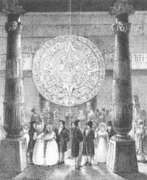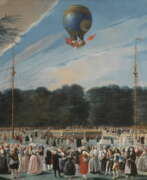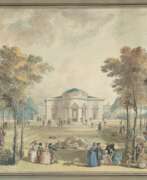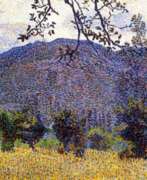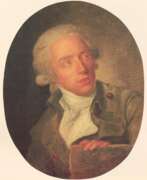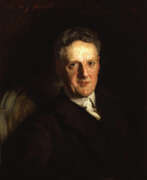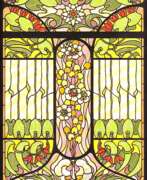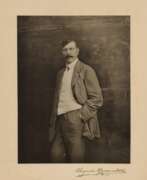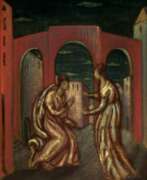Decorators 19th century


Louise Abbéma was a French painter, sculptor, and designer, celebrated for her work during the Belle Époque. Born in Étampes in 1853 into an affluent Parisian family, she became well known for her portraits, particularly of the famous actress Sarah Bernhardt, and for decorative panels commissioned for various public buildings in Paris and the Palace of the Governor in Dakar, Senegal.
Abbéma's art often depicted the upper echelons of French society and reflected the Impressionist style through her light and rapid brushstrokes. She was also notable for her involvement in the women's movement, where she contributed to the emerging image of the 'New Woman' by portraying androgynous figures and themes of intellectualism and freedom.
Among her many honors, Abbéma was awarded the Palme Academiques in 1887, nominated as the Official Painter of the Third Republic, and in 1906, she became a Chevalier of the Legion of Honour. Her works, such as "Lunch in the Greenhouse" and "Portrait of Sarah Bernhardt," have seen a resurgence in popularity as the contribution of women to historical art gains more recognition.
For those interested in the evocative and historically rich artworks of Louise Abbéma, consider subscribing to our updates. We'll keep you informed about new sales, auctions, and exhibitions featuring Abbéma's work, ensuring you're always connected to the latest offerings in the art and antique collectors' sphere.




Boris Izraelievich Anisfeld (Russian: Борис Израилевич Анисфельд) was a Russian-American painter, set designer, illustrator, and educator, celebrated for his vivid use of color and imaginative scenery. Born in Bessarabia, Russian Empire, in 1878, Anisfeld's artistic journey led him from the Odessa School of Art to the Imperial Academy of Arts in Saint Petersburg, where he absorbed the influences of prominent artists like Ilya Repin and Igor Grabar. His distinct style caught the attention of Sergei Diaghilev, leading to his work with the Ballet Russe before World War I.
Anisfeld's contributions to art extend beyond his canvas, as his theater designs for Diaghilev's Ballets Russes and collaborations with notable figures like Michel Fokine and Anna Pavlova showcased his ability to blend fantasy with performance. His work with the Ballets Russes, including designing the production of "Sadko" and executing the visions of other celebrated artists for stage sets, marked a significant period in his career before he immigrated to the United States in 1917.
In America, Anisfeld continued his legacy, taking on roles such as a teacher at the Art Institute of Chicago and contributing to the cultural landscape through his stage designs and paintings. His work is recognized for its innovative approach to color and form, bridging the realms of painting and theater design to create immersive, emotionally resonant artworks. Anisfeld passed away in 1973, leaving behind a body of work that continues to inspire and captivate audiences.
For collectors and experts in art and antiques, Anisfeld's work represents a fusion of Russian and American art traditions, enriched by his imaginative approach and vibrant palette. His contributions to the development of modern art and theater design underscore the enduring relevance of his creative vision.
To stay updated on exhibitions, sales, and auctions related to Boris Israelievich Anisfeld, sign up for updates. This subscription will ensure you're informed about new opportunities to explore and acquire works by this influential artist.


Anatoly Afanasyevich Arapov (Russian: Анатолий Афанасьевич Арапаов) was a Russian and Soviet artist, born in St. Petersburg in 1876 and passing away in Moscow in 1949. His artistic journey began after graduating from high school in 1892, leading him to study at the Moscow Boundary Institute where he initially acquired artistic skills. Arapov's dedication to art became undeniable, prompting him to enroll in the Moscow School of Painting, Sculpture and Architecture in 1897, where he was deeply involved in applied art, book design, and theater.
Arapov's early works, particularly around 1900 and 1910, were influenced by Symbolism, but he transitioned through a phase of Constructivism in the 1920s before dedicating himself to Socialist Realism from the 1930s onward. His versatile talent spanned across painting, graphic arts, and set design, making significant contributions to theater and film. Notably, he designed plays for leading theaters across major Russian cities and worked on popular films in the 1920s and 1930s.
His oeuvre includes portraits, still lifes, and landscapes, featuring views of ancient parks and Russian architecture. Arapov's works are celebrated for their stylistic diversity, capturing the essence of Symbolism, Constructivism, and Socialist Realism. His contributions are recognized in museum collections, including the State Tretyakov Gallery and the Saratov State Art Museum named after Radishchev, among others.
For collectors and art experts, Arapov's works offer a glimpse into the evolving art styles of early to mid-20th century Russia. To stay informed on sales and auction events featuring Anatoly Afanasyevich Arapov's art, signing up for updates can provide exclusive access to new discoveries and opportunities to acquire pieces by this multifaceted artist.


Charles Garabed Atamian is a French artist of Armenian origin born in Turkey.
He studied for a time at the Academy of Fine Arts in Venice, then worked as chief designer at a porcelain factory in Istanbul. In 1894, Atamian worked with a team of artists to decorate the new palace of Sultan Abdul-Hamid Il in Yildiz, on the European side of the Bosphorus. He designed, among other things, the patterns for the ceramic tiles of the palace walls.
In 1897, Atamian emigrated to France and began illustrating books and magazines, as well as working on sets for several Parisian theaters. Since 1903 Atamian participated in various exhibitions with unquestionable success. He painted landscapes, sea and beach scenes with children (including some 200 paintings at Saint-Gilles in the Vendée, where he resided each year during the summer months from 1923 to 1939). Throughout his career he was a fine portrait painter. He became a member of the National Society of Artists in 1927.


Pyotr Vasilievich Basin (Russian: Пётр Васильевич Басин) was a Russian painter, born in 1793 and passed away in 1877, renowned for his large-scale religious, historical, and portrait artworks. A distinguished member of the Imperial Academy of Arts in Saint Petersburg, Basin's career was marked by a significant period in Rome, where he studied under a fellowship and produced nearly a hundred paintings.
Basin's artistic legacy includes notable works such as the allegorical figures for the Winter Palace and several religious scenes for the Saint Isaac's Cathedral and Kazan Cathedral. His contributions extend to teaching roles at the Imperial Academy, where he influenced future generations until his retirement due to a progressive eye disease.
Basin's works are prominently displayed in the Russian Museum among other locations, serving as a testament to his skill and dedication to the arts. For collectors and enthusiasts looking to explore more about Basin's works or receive updates on sales and auctions featuring his art, signing up for specialized newsletters can provide timely and exclusive information.


Aubrey Vincent Beardsley was an English artist and illustrator, whose brief yet impactful career left an indelible mark on the art world. Born in Brighton, England, in 1872, Beardsley's work was instrumental in the development of the Art Nouveau movement, and he is often remembered for his bold, innovative illustrations that challenged Victorian sensibilities with their erotic and often grotesque imagery.
Beardsley's artistic journey was characterized by his unique ability to blend influences from Japanese woodcuts with the aesthetic of the English Art Nouveau movement. His illustrations are distinguished by their stark contrasts of black and white, intricate details, and the absence of middle tones, creating a dramatic and unmistakable style. He was particularly known for his illustrations for the limited edition of "Le Morte D'Arthur," which were celebrated for their elaborate detail and pre-Raphaelite influences, despite their sometimes grotesque details. This work, along with his contributions to "The Yellow Book" and illustrations for Oscar Wilde's "Salome," showcased his talent for capturing the decadent and the macabre, earning him both acclaim and controversy (Wikipedia, The Collector).
Beardsley's career, though short-lived due to his untimely death at the age of 25 from tuberculosis, was marked by significant contributions to various publications, including "The Studio" and "The Savoy," which he co-founded. His work for "The Yellow Book," where he served as art editor, was particularly influential. The magazine, using the latest image-reproduction technology of the time, allowed Beardsley to make dramatic use of black and white space, reflecting his vision of modern life and aesthetics (V&A Museum).
Despite facing health challenges and controversies, including being dismissed from "The Yellow Book" during the scandal surrounding Oscar Wilde's arrest, Beardsley continued to work on projects that pushed the boundaries of conventional morality and art. His illustrations for works like Aristophanes' "Lysistrata" and his retelling of the Tannhäuser legend are testament to his enduring creative spirit and his willingness to explore themes of decadence, sexuality, and the grotesque.
Beardsley's legacy extends beyond his death, influencing not only the Art Nouveau movement but also future generations of artists and illustrators. His work continues to be celebrated for its daring originality and its challenge to the norms of his time. The Victoria and Albert Museum, among others, has celebrated Beardsley's contributions to art and culture, showcasing his ability to intertwine the beautiful and the grotesque in ways that remain provocative and engaging to this day.
For collectors and experts in art and antiques, Beardsley's work offers a fascinating glimpse into the aesthetic and cultural shifts of the late 19th century. His influence on poster art, illustration, and the broader Art Nouveau movement underlines the significant impact he had during his brief career. To stay updated on sales and auction events related to Aubrey Vincent Beardsley's work, signing up for updates can provide exclusive access to the continuing legacy of this remarkable artist.


Karl Petrovich Beggrov (Russian: Карл Петрович Беггров) was a Russian artist known for his exceptional lithographs and watercolor paintings. Born in 1799, Beggrov studied at the St. Petersburg Academy of Arts under M.N. Vorobyov and later worked in his brother's lithographic workshop. His talent spanned various art forms, including portraits, landscapes, and cityscapes, which captured the essence of 19th-century St. Petersburg.
Beggrov's work is particularly celebrated for its detailed and vivid portrayals of St. Petersburg. His series "Views of St. Petersburg and Its Environs," created between 1821 and 1826, remains one of the most significant contributions to early Russian lithography. These works were a collaborative effort with other artists, yet Beggrov's distinctive style is evident in the 28 lithographs he produced for the series.
Several of Beggrov's artworks are housed in major museums, including the Metropolitan Museum of Art. Notable pieces like "Our Lady of Vladimir Church in St. Petersburg" and "View of the Arch of the General Staff Building Towards the Winter Palace" showcase his mastery of lithography and his ability to convey architectural grandeur with precision.
For collectors and art enthusiasts, staying updated on Karl Petrovich Beggrov's works is essential. Subscribe to our updates for notifications on new product sales and auction events related to Beggrov's art.


Pavel Petrovich Benkov (Russian: Павел Петрович Беньков) was a Russian and Soviet artist of the first half of the twentieth century. He is known as a painter, graphic artist, theater decorator, and teacher.
Pavel Benkov created portraits, landscapes, cityscapes, genre paintings. His style in his mature years can be described as impressionist, with attention to color and light. In 1929 he moved to Central Asia, where his style took on unique characteristics, reflecting local landscapes and culture. His work has had a significant influence on the painting traditions of Uzbekistan and Central Asia.


Alexandre Nikolayevich Benois (Russian: Алекса́ндр Никола́евич Бенуа́) was a distinguished Russian artist, art critic, and historian, celebrated for his pivotal role in the art world, particularly in painting and stage design. Born into a family deeply embedded in the cultural fabric of Russia, Benois was instrumental in the development of the Russian artistic movement at the turn of the 20th century. His contributions to art and culture extend beyond his vivid paintings; he was a founding member of the World of Art (Mir iskusstva), a significant art movement and magazine that sought to elevate Russian artistry on the global stage.
Benois' work is notable for its intricate detailing, vibrant use of color, and the ability to convey deep narratives within each piece. His designs for ballets such as "Petrushka" and "The Sleeping Beauty" remain iconic, showcasing his mastery over the fusion of visual art and performance. This synthesis not only enhanced the ballets’ visual appeal but also deepened the audience's engagement with the narrative. Museums and galleries around the world, including the Russian Museum in St. Petersburg and the Tretyakov Gallery in Moscow, house his works, underscoring his global recognition and the enduring appeal of his artistic vision.
For collectors and experts in art and antiques, Benois' oeuvre represents a fascinating exploration of early 20th-century Russian culture, art, and the avant-garde movement. His ability to blend traditional Russian themes with the modernist trends of his time makes his work a valuable study in the evolution of modern art. Those interested in the rich tapestry of Russian cultural history and the interplay between art and performance will find Benois' contributions invaluable.
To stay informed about new discoveries, sales, and auction events related to Alexandre Nikolayevich Benois, we encourage you to sign up for updates. This subscription is tailored specifically for enthusiasts eager to deepen their appreciation and understanding of Benois' legacy, ensuring you're the first to know about opportunities to acquire pieces connected to this luminary of Russian art.


Ivan Yakovlevich Bilibin (Russian: Ива́н Я́ковлевич Били́бин) was a Russian illustrator, stage designer, and teacher, famed for his fairy tale illustrations and stage designs that drew heavily from Russian folklore and traditional art. Born in 1876 in St. Petersburg and passing away in 1942 during the Siege of Leningrad, Bilibin's career spanned a period of great change in Russia, from the pre-revolutionary times through to the Soviet era. His work is celebrated for its intricate detail, vibrant colors, and deep homage to Slavic myths and legends.
Bilibin's journey into the world of art and folklore began after his studies at the St. Petersburg University and the Munich art school. He was deeply influenced by Russian folklore, as well as modern French and Japanese art. This amalgamation of influences resulted in a unique style that made his work stand out. His illustrations for Russian folk tales, such as "The Frog Princess," "Vasilisa the Beautiful," and "Marya Morevna," are among his most celebrated works, encapsulating the essence of Russian narrative traditions.
Bilibin's career was not confined to illustration. He made significant contributions to the world of theater, designing sets for operas and ballets that further entrenched his reputation. His work took him beyond Russia, with periods spent in Egypt and France, where he continued to produce work for the Russian émigré and European communities. Despite the political turmoil of his time, Bilibin remained deeply connected to his roots, returning to Soviet Russia in 1936, where he continued his artistic and academic pursuits until his death in 1942.
For collectors and experts in art and antiques, Bilibin's works represent a bridge between the mystical past and the artistic innovations of the early 20th century. His legacy is preserved in museums and galleries worldwide, offering a glimpse into a world where folklore and art intertwine.
If you are keen to explore more about Ivan Yakovlevich Bilibin's remarkable contributions to art and folklore, consider signing up for updates. This subscription will keep you informed about new sales, auctions, and exhibitions related to Bilibin's work, ensuring you never miss an opportunity to engage with the magical worlds he created.


Vladimir Lukich Borovikovsky (Russian: Влади́мир Луки́ч Боровико́вский), a distinguished Russian artist of Ukrainian Cossack origin, was renowned for his mastery in portrait painting and ecclesiastical art. Born in Mirgorod, now Myrhorod, Ukraine, in 1757, Borovikovsky lived in Ukraine until the age of 31 before moving to St. Petersburg. His journey into the art world began under unusual circumstances when Empress Catherine II was impressed by his allegorical paintings, leading him to relocate to Saint Petersburg and adopt the more aristocratic surname Borovikovsky.
Borovikovsky's work epitomizes the sentimentalism era, capturing the essence and inner beauty of his subjects with a unique sensitivity and elegance. His ability to convey the nuanced emotions and dignified personalities of his sitters through intimate and detailed portraiture earned him acclaim, particularly among the Russian imperial family and nobility. Throughout his career, he produced about 500 portraits, with 400 surviving today, including notable figures such as Catherine II, Paul I, and Alexander Kurakin, as well as the celebrated "Portrait of M.I. Lopukhina".
In his later years, Borovikovsky's focus shifted towards religious painting, contributing significantly to the Kazan Cathedral and other ecclesiastical sites in St. Petersburg. Despite facing challenges, including court intrigues and a personal struggle with mental discord and alcohol, he left a lasting legacy through his art, which remains highly regarded for its depth, sincerity, and technical skill.
Collectors and experts in art and antiques cherish Borovikovsky's work for its historical significance and profound emotional resonance. His paintings, a fusion of classicist and sentimental styles, continue to inspire and captivate audiences, preserving the legacy of one of Russia's most gifted portraitists.
For updates on exhibitions and auction events featuring Vladimir Lukich Borovikovsky's work, sign up for our newsletter. Stay informed about the latest discoveries and opportunities to add a piece of history to your collection.


Georges Braque, a French artist, is celebrated as a pivotal figure in the development of Cubism, alongside Pablo Picasso. Braque's artistic journey transitioned from Impressionism to Fauvism before he delved into the groundbreaking realm of Cubism, characterized by its innovative use of perspective and geometric forms. His partnership with Picasso during the early 20th century marked a significant phase in art history, as they collectively pioneered the Analytic and Synthetic phases of Cubism.
Georges Braque's oeuvre is renowned for its technical precision, introspective quality, and harmonious color palettes. His contributions extended beyond painting to include sculpture and collage, demonstrating his versatile mastery over various mediums. Notable works like "Violin and Candlestick" and "Man with a Guitar" underscore his talent in transforming everyday objects into abstracted, multifaceted compositions.
Throughout his career, Georges Braque remained deeply committed to exploring the boundaries of visual perception and form. After World War I, his style evolved, incorporating brighter colors and new themes, yet he maintained a steadfast adherence to Cubist principles. His later years saw a focus on personal motifs, such as birds, which symbolized freedom and dynamism in his art.
Georges Braque's legacy is preserved in prestigious collections worldwide, including the Museum of Modern Art (MoMA), which houses a significant number of his works. His artistic innovations continue to inspire and influence the realms of art and culture.
For collectors and art enthusiasts, Georges Braque's work offers a profound insight into the evolution of modern art and the enduring allure of Cubism. His pieces are a testament to the enduring power of creativity and innovation in the face of changing artistic landscapes.
If you're keen on exploring Braque's contributions to art and wish to stay updated on exhibitions and sales featuring his work, consider subscribing for updates on Georges Braque's pieces and their presence in the art market today.




Arthur Brusenbauch was an Austrian painter. Arthur Brusenbauch learned from Johann Kautsky and then worked as a stage decorator himself. He studied in Vienna at the Staatsgewerbeschule and the Academy of Fine Arts, interrupted by military service and imprisonment. In 1920 he became a member of the Vienna Secession, and in 1939 he moved to the Künstlerhaus. In 1928 he had represented Austria in the art competitions of the 1928 Olympic Games. From 1937 to 1941 he participated in all major German art exhibitions in Munich with seven oil paintings. There, in 1939, Hitler acquired the picture of Melk an der Donau in festive decorations. Brusenbauch, who is attributed to late impressionism, dealt with fresco painting and graphics.


Karl Pavlovich Bryullov (Russian: Карл Па́влович Брюлло́в), a distinguished Russian artist, emerged as a pivotal figure in the world of 19th-century art, blending Western European Romanticism with his Russian heritage to create works that continue to captivate audiences today. His mastery in painting and architecture set him apart, making him a celebrated figure not just in Russia, but across Europe.
Bryullov's acclaim primarily stems from his remarkable ability to infuse his paintings with vibrant life and emotion, a testament to his profound understanding of human expression and the dramatic interplay of light and shadow. His most famous work, "The Last Day of Pompeii," exemplifies this skill, showcasing an epic narrative filled with vivid detail and emotional depth. This masterpiece, which is housed in the State Russian Museum in St. Petersburg, has garnered international praise for its innovative approach to historical painting, merging accuracy with dramatic storytelling.
Beyond "The Last Day of Pompeii," Bryullov's portfolio includes a range of subjects, from majestic portraits to serene landscapes, each bearing his signature blend of realism and romanticism. His works are featured in prestigious galleries worldwide, serving as a testament to his enduring influence on the art world. For collectors and experts in art and antiques, Bryullov's oeuvre offers a fascinating glimpse into the evolution of 19th-century European painting, marked by a unique intersection of culture, art, and history.
For those intrigued by the enduring legacy of Karl Pavlovich Bryullov and his contributions to painting and sculpture, we invite you to sign up for updates. Our subscription service provides exclusive alerts on new product sales and auction events related to this illustrious artist, ensuring that enthusiasts and collectors alike stay informed about opportunities to engage with Bryullov's remarkable works.


Daniel Caffé was a distinguished German pastel painter of portraits. Known for his meticulous craftsmanship and the emotive depth of his portraiture, Caffé initially embarked on a career in architectural decoration before his talents led him to Dresden to become a portrait artist.
Daniel Caffé's journey into the world of fine arts was marked by his study at the Dresden Academy of Fine Arts under the guidance of significant figures like Casanova and the influence of neoclassical artist Anton Raphael Mengs. His mastery of pastel made him a favored portraitist among the nobility and notable figures of his time, including Russian patrons like Prince Beloselski and Admiral Fyodor Grigoryevich Orloff.
His works, celebrated for their detailed and expressive nature, capture the essence of his subjects with striking realism and emotional depth. Among his notable works are portraits of prominent individuals such as Johann George Tromlitz and Karl August von Hardenberg, which not only exemplify his skill but also his contribution to the documentation of his era's influential figures.
Daniel Caffé's legacy as a pastel painter is preserved in various art collections and continues to be admired for its historical significance and artistic merit. He passed away on January 16, 1815, in Leipzig, leaving behind a body of work that continues to be studied and revered in the art community.
For collectors and experts in art and antiques, Daniel Caffé's portraits offer a glimpse into the refined pastel techniques and cultural narratives of the late 18th to early 19th century. His works remain a significant part of German art history, celebrated for their contribution to the development of portrait painting.
To explore more about Daniel Caffé’s life and works, consider signing up for updates on exhibitions and auctions where his art is featured. This will provide opportunities to engage more deeply with the legacy of this notable artist.


Hans Christiansen was a German painter, representative of classical modernism, decorator and illustrator.
Christiansen trained as a decorative painter in Flensburg and then at the School of Applied Arts in Munich, later studying at the Académie Julian in Paris. After a study trip to Italy in 1889, he moved to Hamburg, where he taught at the Technical University.
At the same time, Christiansen worked as a freelance decorative artist and was active in the Volkskunst-Verein, and was one of the founders and first residents of the Darmstadt artists' colony of the late 19th and early 20th century. Together with Josef Olbrich and Peter Behrens, he designed furniture, ceramics, tapestries, stained glass and graphic posters. He also designed his own house in the colony, which he called "Villa Rose," which was destroyed during World War II.
During this time, the versatile artist also wrote regularly for the magazine Jugend, creating many illustrations and covers. From 1911 he lectured at the Wiesbaden School of Arts and Crafts and was a member of the Wiesbaden Free Artists Association.
In 1933, Christiansen's work was banned by the Nazi Party of Germany because of his Jewish wife, and he was almost forgotten until his death in 1945.


Charles-Louis Clérisseau was a French architect, draughtsman, antiquary, and artist who became a leading authority on ancient Roman architecture and Roman ruins in Italy and France. With his influence extending to Russia, England, and the United States, and clients including Catherine the Great and Thomas Jefferson, Clérisseau played a key role in the genesis of neoclassical architecture during the second half of the 18th century.
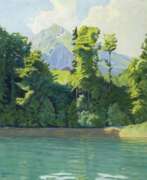

Plinio Colombi was a Swiss painter and graphic artist. For his paintings he often chose landscape motifs of the Lake Thun region and also painted still lifes. His works include prints, paintings, etchings, aquatints, lithographs, woodcuts, drawings, and posters.


Walter Crane was an English artist and book illustrator. He is considered to be the most influential, and among the most prolific, children's book creators of his generation and, along with Randolph Caldecott and Kate Greenaway, one of the strongest contributors to the child's nursery motif that the genre of English children's illustrated literature would exhibit in its developmental stages in the later 19th century.
Crane's work featured some of the more colourful and detailed beginnings of the child-in-the-garden motifs that would characterize many nursery rhymes and children's stories for decades to come. He was part of the Arts and Crafts movement and produced an array of paintings, illustrations, children's books, ceramic tiles, wallpapers and other decorative arts. Crane is also remembered for his creation of a number of iconic images associated with the international Socialist movement.


Antonio Gómez Cros was a Spanish painter, lithographer and decorator.
Antonio began studying painting at the Academy of Fine Arts of San Carlos in Valencia and completed his studies at the Royal Academy of Fine Arts of San Fernando. He was a representative of early romanticism with signs of classicism.
Antonio Gómez Cros specialized in historical scenes and was a recognized portrait painter. In 1846 he was appointed honorary chamber painter to Elizabeth II and painted several famous historical, battle and religious paintings in this position. The artist also painted walls and curtains in palaces and theaters.




Pierre-Antoine Demachy was a French painter and master of architectural landscapes.
He studied architecture at the Royal Academy of Painting and Sculpture and specialized in drawing ruins, architectural structures and scenery. Due to his success in his art, he became a royal master of architectural decorations for entertaining events. Demachy also taught students of painting at the Louvre Palace.


Raoul Dufy, a renowned French artist, is celebrated for his vibrant and decorative style, which left a significant mark in the realms of Fauvism and Post-Impressionism. Born in 1877 in Le Havre, France, Dufy's artistic journey was profoundly influenced by Henri Matisse's Fauvist work "Luxe, Calme et Volupté," which he encountered at the Salon des Indépendants in 1905. This experience steered him towards Fauvism, a style that emphasized bold contours and bright colors.
Dufy's artistic evolution saw him briefly embrace Cubism around 1920, after which he developed a unique approach. This approach, often referred to as stenographic, was characterized by skeletal structures, foreshortened perspectives, and the use of thin, quickly applied washes of color. His works, known for their cheerful and fashionably decorative nature, often depicted scenes of leisure like yachting, the French Riviera, and chic parties, capturing the essence of the period's optimism.
In addition to his painting, Dufy was also a commercial artist, illustrator, and designer, contributing significantly to textile design and public murals. His large-scale public art commissions combined modern and allegorical subjects with exuberant outlines and intense colors, showcasing a modernist take on traditional mural work. Notable works by Dufy include "The Regatta," "The Harvester," and the monumental "The Electricity Fairy," a large mural commissioned for the 1937 World's Fair in Paris.
His works are housed in prestigious public collections worldwide, including the Art Institute of Chicago, the Musée d'Art Moderne de Paris, and the National Gallery of Art in Washington, D.C. Despite his artistic achievements, Dufy's focus on decorative art and the lack of engagement with wider social concerns has led to a varied critical reception of his work. Nonetheless, his contribution to 20th-century art, particularly in popularizing a vibrant and illustrative style, remains undisputed.
If Raoul Dufy's artistry captivates you and you wish to stay informed about the latest artworks, exhibitions, and auction events related to this remarkable artist, we invite you to sign up for our updates. By subscribing, you'll receive timely notifications about new pieces for sale and upcoming auctions. This is a wonderful opportunity for collectors and art enthusiasts to enhance their appreciation and possibly their collections of Dufy's work. Stay connected with the world of art and don't miss any chance to acquire unique pieces by this celebrated artist.


Ivan Semyonovich Efimov (Russian: Иван Семёнович Ефимов) was a Russian and Soviet artist of the first half of the twentieth century. He is known as an animal painter, graphic artist, sculptor, illustrator and reformer of the puppet theater.
Ivan Efimov worked in different genres and techniques, but all his work, including decorative and applied art, was focused on animalistic themes. He created works for the Moscow subway, train stations, sanatoriums and many other places and became famous for his technique of through volume relief in sculpture. The master also illustrated more than 20 books.
Efimov also created erotic works - about a thousand sheets with various thematic series, but the public learned about them only after the collapse of the USSR.


Aleksandra Aleksandrovna Ekster (Russian: Алекса́ндра Алекса́ндровна Эксте́р), a luminary of the Russian avant-garde, was a painter and designer whose work traversed the boundaries of Cubo-Futurism, Suprematism, and Constructivism, eventually influencing the Art Deco movement. Born in Białystok (then part of the Russian Empire, now Poland) and later splitting her life among Kiev, St. Petersburg, Moscow, Vienna, and Paris, Ekster played a pivotal role in bridging Russian and European artistic movements. Her innovative approach to art was characterized by dynamic movement, vibrant color contrasts, and geometric compositions, which were evident in her paintings, theater set and costume designs, and educational endeavors.
Ekster's studio became a hub for the intellectual and artistic elite, hosting figures like poets Anna Akhmatova and Osip Mandelstam, as well as painters Pablo Picasso and Georges Braque during her stays in Paris. Her involvement in significant art exhibitions, such as the Salon des Indépendants and the Salon de la Section d'Or in Paris, showcased her works alongside those of Jean Metzinger, Marcel Duchamp, and others, marking her as a key figure in the avant-garde community.
Beyond painting, Ekster's contributions to theater and design were profound. She worked on costume and set designs for Alexander Tairov's Chamber Theatre and participated in the revolutionary festivities' decoration in Kiev and Odessa. Ekster's pedagogical efforts included teaching at the Higher Artistic-Technical Workshop (VKhUTEMAS) in Moscow, fostering a new generation of avant-garde artists.
Ekster's work is housed in various international and private collections, reflecting her lasting impact on the art world. Her ability to integrate different genres and styles, along with her commitment to experimentation and innovation, made her one of the most influential women in the Russian avant-garde.
For those fascinated by the pioneering spirit of Aleksandra Aleksandrovna Ekster and the avant-garde movement, signing up for updates on new product sales and auction events related to her work is a compelling way to stay informed. This subscription ensures enthusiasts and collectors are always in the loop regarding opportunities to engage with Ekster's enduring legacy.


Girolamo Franceschini was an Italian theater artist, draftsman, and lithographer who worked in Austria.
From 1848-1859 Franceschini worked as a costume designer for two court theaters in Vienna, designing original costumes for many plays and operas. Franceschini was also for a time a contributor to the Illustrated Theater Newspaper there and published numerous series of illustrations.


Johann Georg Grimm was a German painter of the mid-nineteenth century. He is known as a landscape painter and designer, most famous for his works created during his stay in the Brazilian Empire.
Georg Grimm is recognized as the preeminent master of Brazilian art and is considered a leader of modernism in that country. He had a significant influence on the development of modern painting in Brazil, founding a plein air school and becoming a teacher. His naturalistic landscapes are recognized as a valuable legacy and many are in private collections. In Germany he remained little known.


Hermann Hendrich was a German painter of the last quarter of the nineteenth and first third of the twentieth centuries. He is known as a painter known for his works in the Romantic and Old Germanic style.
Hendrich considered the canvases and interior for the "Walpurgis Hall" near Thale, created in 1901, to be the pinnacle of his work. For the "Nibelungen Hall" on Mount Drachenfels, opened in 1913 in honor of Richard Wagner, he painted 12 canvases based on ancient Germanic legends. The artist also created illustrations for Goethe's works, as well as exhibitions in the "Hall of German Sagas" in Solingen.
Hendrich was a co-founder of the Verdandi Union, which opposed modernism in art. A square in Berlin, Gendrichplatz, is named in his honor.


Henry Noel Humphreys was a British artist, illustrator, naturalist, entomologist and numismatist.
He was educated at King Edward's School and studied medieval manuscripts in Italy, and became a distinguished scholar in many fields of science. In addition to publications on entomology, Humphreys wrote works on ancient Greek and Roman coins, archaeology, and the art of writing and printing.
Humphreys was a successful book illustrator, and is also known for publishing sumptuous books whose design is reminiscent of medieval carved and jeweled bindings.


Georg Janny was an Austrian landscape painter and set designer.
He worked as a scene painter in the studios of Carlo Brioschi and Johann Kautsky, alongside Alfons Mucha, and was a member of the Dürerbund.
He also painted landscapes and figures, including scenes from fairy-tales or imaginary worlds that are reminiscent of the works of Arnold Böcklin or Gustave Doré.


Owen Jones was a British architect, designer, theorist and decorative arts artist.
Educated at the Royal Academy, Jones traveled to the Middle East and Spain between 1833 and 1834, studying the architecture and design of the Islamic and especially the Arab world. Jones dedicated his work Plans, Facades, Sections, and Details of the Alhambra (1842-45) to the famous palace at Granada, an outstanding example of Moorish architecture.
Jones is also known for his work on Eastern and Western design motifs, Grammar of Ornament (1856), which is a systematic pictorial compendium emphasizing the use of color and the application of logical principles in the design of carpets, wallpaper, furniture, and interior decoration.
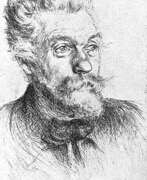

Charles Jouas, born Charles Alfred Auguste Jouas, was a French painter, illustrator and designer, and printmaker.
Charles studied painting in workshops with various artists and worked on theater sets. In 1896 he met the famous bibliophile Henri Beraldi, and this meeting was decisive: the artist had promising orders. Then began a long collaboration with the engraver Henri Paillard (1846-1912).
Charles Jouas specialized in cityscapes of Paris, from 1890s worked as an illustrator for rare books. Then he began engraving his own drawings and experimenting with etching, and became president of the engraving section of the National Society of Fine Arts.


Paul Kayser was a German painter and graphic artist. After training as a painter-decorator, Kayser attended the Schools of Applied Art in Munich and Dresden.
Paul Kayser was a founding member of the Hamburg Artists' Club 1897 and the Hamburg Secession, and a member of the Hamburg Artists' Association and the Altona Artists' Association. His style was decisively influenced by Albert Marquet, whom Kaiser met in 1909.
In 1937, Kaiser's still life was confiscated from the museum in Husum as part of the Nazi "Degenerate Art" campaign.


Fernand Khnopff, full name Fernand-Edmond-Jean-Marie Khnopff, was a Belgian Symbolist painter, graphic artist, sculptor and art historian.
Born into a wealthy family, Fernand attended the Royal Academy of Fine Arts in Brussels, where he studied painting with Xavier Mellerie. Throughout his years at the academy, Khnopff spent summers in Paris studying art, and at the 1878 World's Fair he saw the works of Pre-Raphaelite Edward Burne-Jones and Symbolist Gustave Moreau, which had a decisive influence on his work.
In the early 1880s Khnopff began to exhibit his Symbolist works, often inspired by literary works, particularly by Gustave Flaubert. His paintings combined precise realism with an ethereal fairy-tale atmosphere, and he also painted portraits.
In 1883 Khnopff co-founded Les Vingt, a group of Belgian avant-garde artists. From the early 1990s, he collaborated regularly with the Brussels opera house Royal de la Monnaie, designing costumes and sets for many productions. He also designed the interiors of Brussels' landmark buildings: the Maison Stoclet and the Hôtel de Ville in Saint-Gilles.


Stepan Fedorovitch Kolesnikoff (Russian: Степан Федорович Колесников) was a Ukrainian realist painter renowned for his exceptional ability to capture the essence of Ukrainian nature and rural life. Born in 1879 in the Russian Empire and passing in 1955 in Belgrade, Yugoslavia, Kolesnikoff's journey began in a humble peasant family. His artistic talent was evident early on, leading him to the Odessa Art School and subsequently, without exams, to the prestigious Imperial Academy of Arts. Here, he was not only a student but also thrived, winning numerous awards for his work.
Kolesnikoff's art is characterized by its focus on the natural awakening of landscapes, melting snows, floods, and the vibrant days of spring. He also had a keen interest in painting domestic scenes filled with people and animals, often using a palette of blues and bright oranges. Despite the rich detail in his paintings, Kolesnikoff rarely highlighted the faces of his subjects, preferring instead to capture the essence of the moment. His work received high praise from Ilya Repin, a leading Russian artist of the time, underscoring Kolesnikoff's significant impact on realism.
After emigrating to the Balkans in 1919 due to the political upheaval in Russia, Kolesnikoff settled in Belgrade where he continued his artistic career. He was warmly welcomed and even participated in state assignments, such as leading restoration works on paintings and frescoes. Kolesnikoff's legacy extends beyond his paintings; he was a respected member of the artistic community, contributing to societies like the "Community of Artists" and "Leonardo da Vinci".
For collectors and experts in art and antiques, Kolesnikoff's work represents a fascinating blend of cultural and historical narratives, imbued with the beauty of Eastern European landscapes and life. His contributions to realism and his unique approach to depicting rural life make his works highly sought after.
To stay updated on exhibitions and auction events featuring Stepan Fedorovitch Kolesnikoff's works, signing up for updates can provide exclusive insights and opportunities to acquire pieces by this remarkable artist.




Elizaveta Sergeyevna Kruglikova (Russian: Елизавета Сергеевна Кругликова) was a Russian-Soviet artist, celebrated for her distinctive contributions to etching, silhouette art, and monotyping. Born into a St. Petersburg family with a deep appreciation for art, Kruglikova's talent blossomed early, supported by the artistic atmosphere at home. She honed her skills at the Moscow School of Painting, Sculpture and Architecture before moving to Paris, where she immersed herself in the city's vibrant art scene. From 1902, she experimented with etching, eventually becoming a notable figure in this field.
Kruglikova's Parisian period was marked by her work at the Académie de La Palette, where she both studied and taught, making significant contributions to the art of etching. Her return to Russia at the onset of World War I marked a new phase in her career, as she began exploring the realm of silhouette art, creating evocative portraits and scenes that captured the spirit of her subjects with striking clarity.
Perhaps most renowned for her pioneering work in monotype, a printing technique that allowed her unique expressivity, Kruglikova's art straddles the line between printmaking and painting. Her creations, ranging from the depiction of Parisian life to the vibrancy of the Russian cultural milieu, reflect a deep engagement with both her subjects and her mediums. The artist's ability to revive and innovate within traditional etching and printing techniques garnered her recognition and admiration, culminating in the dedication of the Fourth International Festival of Monotypes to her legacy.
Her works, characterized by a deep exploration of silhouette and monotype techniques, resonate with collectors and art enthusiasts to this day. Notably, Kruglikova was among the first Russian female artists to establish a studio in Paris, contributing significantly to the art scene there and back in Russia. Her late works include insightful portraits of fellow artists and poets, showcasing her mastery of silhouette style and positioning her as a key figure in the transition between printed graphic art and painting.
For collectors and experts in art and antiques, Kruglikova's legacy offers a fascinating glimpse into the innovative spirit of early 20th-century Russian and Soviet art. Her works not only reflect the artistic movements of her time but also stand as testaments to her individual creativity and technical prowess.
Stay informed about new sales, auction events, and exhibitions featuring Elizaveta Sergeyevna Kruglikova by signing up for updates. This subscription is your gateway to the world of a visionary artist whose work continues to inspire and captivate.


Boris Mikhailovich Kustodiev (Russian: Бори́с Миха́йлович Кусто́диев) was a distinguished Russian artist and painter, celebrated for his vivid portrayal of the Russian culture and way of life. Born in Astrakhan in 1878, Kustodiev's artistic journey began at a young age, leading him to study under the renowned Ilya Repin at the Imperial Academy of Arts. His works, characterized by their rich color palette and intricate detail, capture the essence of Russia's social and cultural fabric during the early 20th century.
Kustodiev's art is notable for its depiction of Russian peasantry, landscapes, and bourgeois celebrations, embodying the spirit and vibrancy of Russian folklore and traditions. His paintings such as "The Merchant's Wife" and "Maslenitsa" are celebrated for their lush visual storytelling and are housed in prestigious museums, including the State Russian Museum in St. Petersburg. These works reflect Kustodiev's fascination with the Russian merchant class and traditional festive gatherings, showcasing his skill in blending realism with a folkloric charm.
Beyond painting, Kustodiev's contributions to theatre and book illustration further demonstrate his versatile talent and deep connection to Russian cultural heritage. Despite facing personal challenges, including a debilitating illness that confined him to a wheelchair, Kustodiev's prolific output continued unabated, leaving behind a legacy that continues to enchant and inspire. His ability to capture the beauty and complexity of Russian life has made his work invaluable to collectors and experts in art and antiques alike.
For those intrigued by the rich tapestry of Russian culture and history as depicted through the lens of one of its most celebrated artists, we invite you to sign up for updates. Stay informed on new product sales and auction events related to the illustrious works of Boris Mikhailovich Kustodiev. This subscription is your gateway to the vibrant world of Russian art, offering exclusive insights and opportunities for collectors and enthusiasts.


Pavel Kuznetsov (Russian: Павел Варфоломеевич Кузнецов) was a Russian artist, celebrated for his pioneering role in the Symbolist movement and his profound influence on the development of Russian modernist art. Born into the late 19th century, Kuznetsov's work spans painting, sculpture, and illustration, showcasing a unique blend of Eastern and Western artistic traditions.
Kuznetsov's art is renowned for its vibrant use of color, ethereal landscapes, and mystical themes. His distinctive style combines traditional Russian iconography with the innovative techniques of European modernism, making his work highly prized among collectors and art enthusiasts. Kuznetsov was a key member of the Blue Rose artist group, which sought to express the spiritual and emotional through art. This collective's contributions are considered seminal in the evolution of Russian Symbolism.
Among Kuznetsov's notable works are his dreamlike paintings of Central Asia, which brought a new dimension to Russian art by introducing themes and aesthetics from Eastern cultures. These pieces are not only significant for their artistic merit but also for how they reflect the cross-cultural exchanges of the early 20th century. Some of his masterpieces are held in prestigious institutions, including the Tretyakov Gallery and the Russian Museum, making them accessible to the public and subject to scholarly study.
For collectors and experts in the fields of art and antiques, Kuznetsov's works represent a valuable intersection of cultural heritage and artistic innovation. His contributions to the Symbolist movement and Russian modernism continue to inspire and influence contemporary art discourse.
To stay informed about new product sales and auction events related to Pavel Kuznetsov, sign up for our updates. This subscription is an excellent resource for collectors looking to enhance their collections with pieces by this distinguished artist. Join our community today and ensure you never miss an opportunity to acquire works by Pavel Kuznetsov.
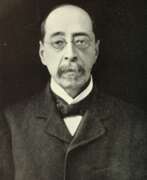

John La Farge was an American artist whose career spanned illustration, murals, interior design, painting, and popular books on his Asian travels and other art-related topics.
La Farge is best known for his production of stained glass, mainly for churches on the American east coast, beginning with a large commission for Henry Hobson Richardson's Trinity Church in Boston in 1878, and continuing for thirty years. La Farge designed stained glass as an artist, as a specialist in color, and as a technical innovator, holding a patent granted in 1880 for superimposing panes of glass. That patent would be key in his dispute with contemporary and rival Louis Comfort Tiffany.


Marie Laurencin was a pivotal figure in the Parisian avant-garde, a French artist renowned for her distinct approach to painting. Unlike her contemporaries who embraced the bold facets of Cubism, Laurencin carved a niche for herself with a palette of soft pastels and a focus on ethereal female forms. Her work, embodying an enchanted, feminine world devoid of masculine presence, was revolutionary for its time, offering a sanctuary of female harmony that was both subtle and profound.
Laurencin's oeuvre extends beyond paintings to include watercolors, drawings, and prints, with notable works such as "Les jeunes filles" and "Portrait de Mademoiselle Chanel" finding homes in prestigious institutions like the Museum of Modern Art in New York and the Musée de l'Orangerie in Paris. Her legacy is further cemented by the Musée Marie Laurencin in Nagano, Japan, the only museum dedicated solely to a female painter, showcasing over 600 of her pieces.
Her approach diverged significantly from the norms of Cubism, incorporating a distinctly feminine aesthetic through the use of pastel colors and curvilinear forms. This unique style set her apart from peers and positioned her as one of the few female Cubist painters, alongside figures like Sonia Delaunay and Marie Vorobieff. Laurencin's artistry was not just an exploration of femininity but a celebration of it, challenging the dominant artistic narratives of her time.
The critique of Laurencin's work for its deliberate embrace of femininity and decorative qualities overlooks the radical essence of her aesthetic. Her paintings, characterized by serene and charming depictions of women, argue for a creative space where the feminine is not just visible but central. Works like "The Fan" and "Spanish Dancers" exemplify her ability to create intimate, self-sufficient worlds that engage the viewer in narratives of absence, longing, and female solidarity.
For collectors and experts in art and antiques, Laurencin's work offers a nuanced understanding of early 20th-century modern art movements through the lens of femininity. Her contributions to art history reflect a bold reimagining of the female form and the spaces women occupy, both in the physical and imaginative realms.
To stay informed about new product sales and auction events related to Marie Laurencin, sign up for updates. This subscription ensures you remain at the forefront of the latest developments and opportunities to acquire works by this groundbreaking artist.


August Laux was a painter and designer of French origin who worked in Germany and the United States.
In 1863 he emigrated with his parents from Germany to New York, where he studied sculpture and painting, then enrolled in courses at the National Academy of Design. In the 1870s he was commissioned to paint sets for a private club theater in Manhattan. After a successful result, Laux's work became in demand in wealthy homes and hotels.
In painting, Laux took on different genres: he painted floral and fruity still lifes, genre animalistic scenes, and rural landscapes.


Heinrich Lefler was an Austrian artist, book illustrator and theatre set designer. He studied painting in Vienna at the Academy of Fine Arts and at the Munich Academy of Fine Arts.
Heinrich Lefler was the chief painter of the Vienna State Opera. Since 1903 he has taught at the Academy of Fine Arts and worked simultaneously as a set designer at the Vienna Burgtheater.
Heinrich Lefler was also one of Austria's first artists active in the field of applied art. He created advertising posters for companies, designed bank notes and painted murals for villas, castles and hotels. Lefler also illustrated numerous editions of magazines, calendars and books.


Hans Makart was an Austrian painter of the second half of the 19th century. He became famous as a master of historical painting, still life, allegory, landscape, and portrait. Most of his paintings were painted in the academic style. Makart was also a sought-after stage decorator, costume designer, furniture and interior designer.
Hans Makart was very popular in Vienna, and his studio was a place of attraction for the cream of Vienna's society. After the artist was even named a separate style of art with its characteristic flowing forms and bright colors - "Makartstil". Makart constantly organized grand festivals in his studio, which were willingly attended by members of the imperial family. He made it ultra fashionable to have a new style of interior and soon most of the apartments of wealthy citizens of Vienna were furnished on the model of his salon.
Makart was a professor of historical painting at the Vienna Academy of Fine Arts and head of the Künstlerhaus, the largest exhibition complex in the Austrian capital. In 1879, on the occasion of the silver wedding of the imperial couple, Makart organized a grandiose theatrical performance, the sketches for which have survived to this day.


Sergey Vasilyevich Malyutin (Russian: Сергей Васильевич Малютин) was a distinguished Russian painter, architect, and designer, celebrated for his multifaceted contributions to the world of art and design. Born in Moscow in 1859 to a merchant family, Malyutin's artistic journey began after an exhibition by the Peredvizhniki inspired him to pursue art. His formal education at the Moscow School of Painting, Sculpture and Architecture honed his talents, leading to a diverse career that spanned painting, set design for operas and ballets, and architectural endeavors.
Malyutin is perhaps best known internationally for designing the first matryoshka doll in 1890, a seminal work that has become an iconic symbol of Russian culture. His involvement in the Arts and Crafts Movement influenced his work, integrating traditional Russian folk motifs into his designs and paintings. Notably, his architectural designs, including the Church of the Holy Spirit in Talashkino and the Pertsov House in Moscow, showcase his dedication to the Russian Revival movement, blending fantastic folk motifs with architectural creativity.
Throughout his career, Malyutin also played a significant role in education, teaching at the Moscow School of Painting, Sculpture and Architecture and advocating for Socialist Realism. His contributions to Russian art were not limited to his creations; he was instrumental in founding the Association of Artists of Revolutionary Russia, emphasizing the importance of art in societal development.
For those interested in exploring the legacy of Sergey Malyutin, his works offer a window into the fusion of traditional Russian art with the innovative currents of his time. Collectors and experts in art and antiques will find his contributions to Russian arts and crafts, especially his role in the creation of the matryoshka doll, to be of particular interest.
To stay updated on exhibitions and auction events featuring Sergey Vasilyevich Malyutin's work, sign up for updates. This subscription is an invaluable resource for enthusiasts looking to deepen their understanding of Malyutin's impact on Russian art and design.


Koloman Moser, an Austrian artist, was a pivotal figure in the Vienna Secession movement and a co-founder of Wiener Werkstätte. His diverse portfolio includes graphic works, fashion designs, stained glass windows, ceramics, silverware, jewelry, and furniture. Moser's style, characterized by precise geometric patterns and a harmonious blend of colors, made a significant impact on 20th-century graphic art and design.
Koloman Moser's work extended beyond art; he designed currency and stamps, notably the Austrian-Hungarian 50 Crown Banknote and a stamp featuring Emperor Franz Joseph. His legacy is preserved in various museums, including the Museum of Applied Arts Vienna (MAK), which hosted a comprehensive exhibition to commemorate the centenary of his death.
For collectors and art enthusiasts, Koloman Moser's creations offer a unique glimpse into the evolution of modern design and the rich cultural tapestry of early 20th-century Vienna. To stay informed about upcoming sales and auction events related to Koloman Moser's work, signing up for updates is an excellent way to stay connected with this influential artist's enduring legacy.
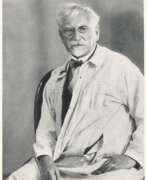

Alfons Maria Mucha, a Czech Art Nouveau painter and decorative artist, was celebrated for his innovative contributions to art, particularly his distinctive style that became synonymous with the Art Nouveau movement. Born in 1860 in the Moravian town of Ivancice, Mucha exhibited artistic talent from a young age, initially showing a proclivity for drawing and music, which were closely intertwined in his perception of creative expression. Despite early financial and educational hurdles, Mucha's passion for art led him to Vienna and subsequently Munich, where he honed his skills and absorbed influences that would shape his future work.
Mucha's career took a pivotal turn in Paris, where his poster for the actress Sarah Bernhardt's play "Gismonda" gained him immediate fame. This partnership with Bernhardt catalyzed a prolific period during which Mucha produced a flurry of artworks, including paintings, posters, and illustrations, as well as designs for jewelry, wallpaper, and theatre sets. His works are characterized by their depiction of beautiful young women in flowing robes, surrounded by lush, natural elements and often featuring pastel colors—a stark contrast to the bold hues preferred by his contemporaries.
Despite his commercial success, Mucha aspired for his art to convey a deeper spiritual message rather than merely adhering to the trendy Art Nouveau style. This led him to undertake projects that were more personal and culturally significant, such as "The Slav Epic"—a series of paintings celebrating Slavic history. Mucha's legacy is not only preserved in his diverse body of work but also in his influence on the aesthetic values of craftsmanship and design.
Collectors and experts in art and antiques continue to venerate Mucha for his unique ability to blend artistic beauty with cultural expression. His works, which are housed in museums and galleries worldwide, remain a testament to his vision and creativity.
For those keen on exploring the world of Alfons Maria Mucha further and staying updated on new sales and auction events related to his work, signing up for updates is an excellent way to ensure you never miss an opportunity to appreciate or acquire pieces related to this iconic artist. This subscription is tailored for collectors and art enthusiasts, focusing solely on new product sales and auction events concerning Mucha's legacy.


Michael Neher was a German painter and architectural decorator.
Michael studied at the Academy in Munich, in 1819 went to Italy and spent five years there, including two years in Rome, where he studied architectural painting in the studio of the artist Heinrich Maria von Hess, and in 1825 returned to Munich.
As a typical representative of the Biedermeier era, Neher produced many costume drawings and landscapes. He also became famous for his views of public places and architectural depictions of many Bavarian towns. From 1837, Michel Neher devoted himself entirely to architectural painting and traveled to improve his skills along the Rhine and to Belgium. In 1839 he painted several salons in Hohenschwangen Castle from designs by Schwind, Gasner and Schwanthaler. In 1876 he was made an honorary member of the Munich Academy.


Bernhard Pankok, full name Bernhard Wilhelm Maria Pankok, was a German painter and graphic artist, designer, applied artist and architect of the Art Nouveau period.
After acquiring skills as a painter and restorer, Bernhard Pankok studied painting at the Düsseldorf Academy of Fine Arts, then in Berlin. In 1892, he began working in Munich in his own painting studio, doing illustrations for the magazines Pan and Jugend, among others. Pancock was one of the founders of the Munich Association of Art Craft Workshops.
In 1897, Pankok began designing furniture and exhibited his work at numerous exhibitions, including the landmark 1900 "Universal and International Exposition" in Paris. In the same year the art historian Konrad Lange commissioned Bernhard Pancock to design the Haus Lange for him; he worked extensively as an architect in general and designed other buildings in Stuttgart. Pankok was prolific and versatile: he designed sets for opera stages and salons for ocean liners and even the passenger cabins of zeppelins, worked as an architect, furniture designer, interior decorator, painter and graphic artist.
In 1907, he co-founded the Deutsche Werkbund. In 1901 he was invited to teach at the Royal Training and Experimental Workshop in Stuttgart; in 1913 he became its head and in that capacity merged it with the School of Arts and Crafts.


Eduard Friedrich Pape was a distinguished German painter and known for his contributions to theatre, decorative, and landscape painting. He honed his skills at the Berlin Academy, studying under Carl Blechen and Wilhelm Schirmer from 1839 to 1843, while also working in Johann Gerst's studio, a renowned theatre and decorative painter. Eduard Friedrich Pape's journey took him to Tyrol, Switzerland, and Italy in 1845, enriching his experience and artistic repertoire.
His talent led to his involvement in decorating Berlin's Neue Museum between 1849 and 1853, after which he was honored with the title of a royal professor and membership at the Berlin Academy in 1853. However, Eduard Friedrich Pape's career faced challenges due to severe illness in 1857, which long hindered his ability to paint. Despite these obstacles, he continued his artistic endeavors until old age, when he struggled with eye problems and was nearly blind by the time of his death in 1905.
Eduard Friedrich Pape's legacy is reflected in his artworks, which have been recognized and appreciated in various auctions, demonstrating his lasting impact on the art world. His works provide a window into 19th-century German art, particularly in landscape and decorative painting, making him a significant figure for collectors and art enthusiasts.
For those interested in exploring the works and contributions of Eduard Friedrich Pape further, consider signing up for updates on new product sales and auction events related to his artwork. This subscription will offer insights and access to the fascinating world of Pape's artistic legacy.


Mikhail Rodionovich Pestrikov (Russian: Михаил Родионович Пестриков) was a Russian and Soviet artist of the late 19th and the first third of the 20th centuries. He is known as a painter and teacher.
Mikhail Pestrikov was engaged in easel and monumental and decorative painting. He wrote portraits, created a number of paintings of biblical themes. The artist also carried out murals in houses, scientific institutions and churches.


Jean-Baptiste Pillement was a French painter and designer, known for his exquisite and delicate landscapes, but whose importance lies primarily in the engravings done after his drawings, and their influence in spreading the Rococo style and particularly the taste for chinoiserie throughout Europe.


Lodovico Pogliaghi is an Italian painter, sculptor and decorator. He studied at the Brera Academy under Giuseppe Bertini.
As a leading representative of eclectic academism, focused on restoring earlier classical styles, Lodovico Pogliaghi devoted himself intensively as a consultant to the Department of Antiquities and as a restorer.


Emil Preetorius was a German illustrator, graphic artist, book designer and art collector. He is also considered one of the most important stage designers of the first half of the 20th century. In 1909, together with Paul Renner, he founded the Schule für Illustration und Buchgewerbe (School for Illustration and Book Design) in Munich, headed the Munich training workshops from 1910, and in 1926 became head of a class for illustration as well as a class for stage design at the Hochschule für Bildende Künste (Academy of Fine Arts) in Munich, where he was a professor from 1928. In 1914, together with Franz Paul Glaß, Friedrich Heubner, Carl Moos, Max Schwarzer, Valentin Zietara, Preetorius founded the artists' association "Die Sechs" (The Six), one of the first groups of artists for the marketing of advertising commissions, especially posters.
Preetorius created illustrations for numerous works of fiction from 1908 onwards. In 1932 he became scenic director of the Bayreuth Festival. In 1944 he made his debut as stage designer for the Richard Strauss premiere of Die Liebe der Danae at the Salzburg Festival. In his book cover designs, literary illustrations, advertisements and posters, Preetorius was influenced by Japanese woodblock prints; as a stage designer, he drew on Romantic classicism.


Friedrich Preller the Elder was a German landscape painter and etcher. From 1832 he was a professor at the Fürstlichen freien Zeichenschule in Weimar. He was the father of the artist Friedrich Preller the Younger.


